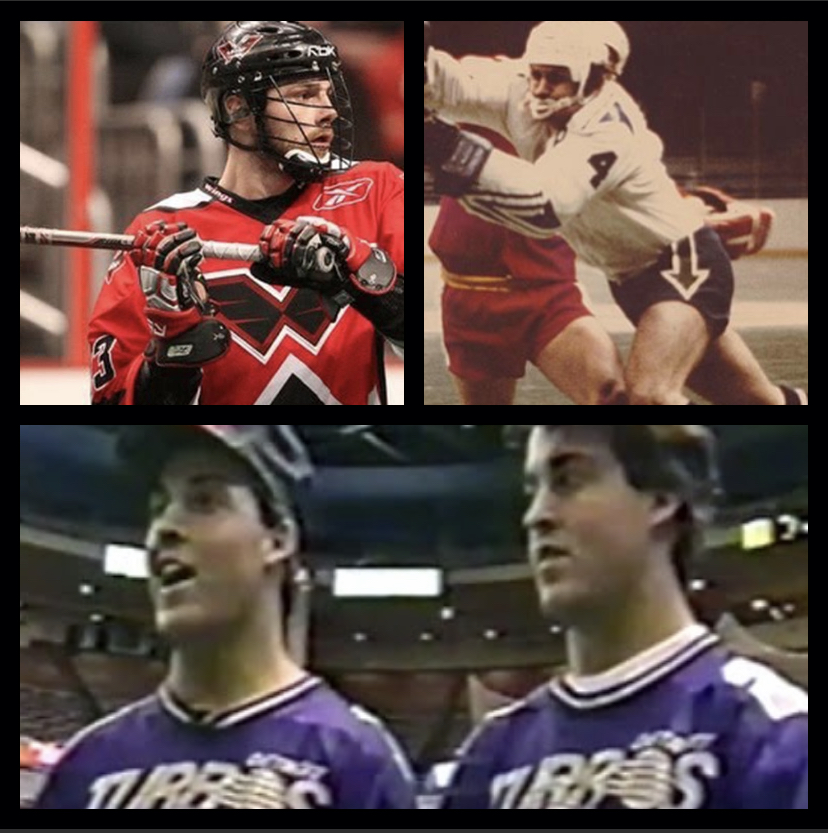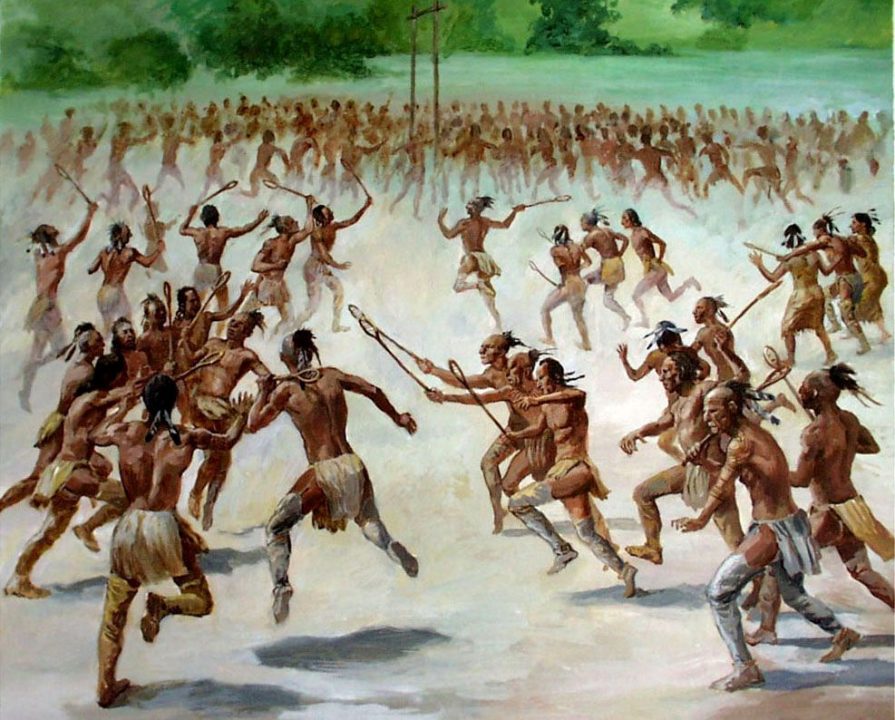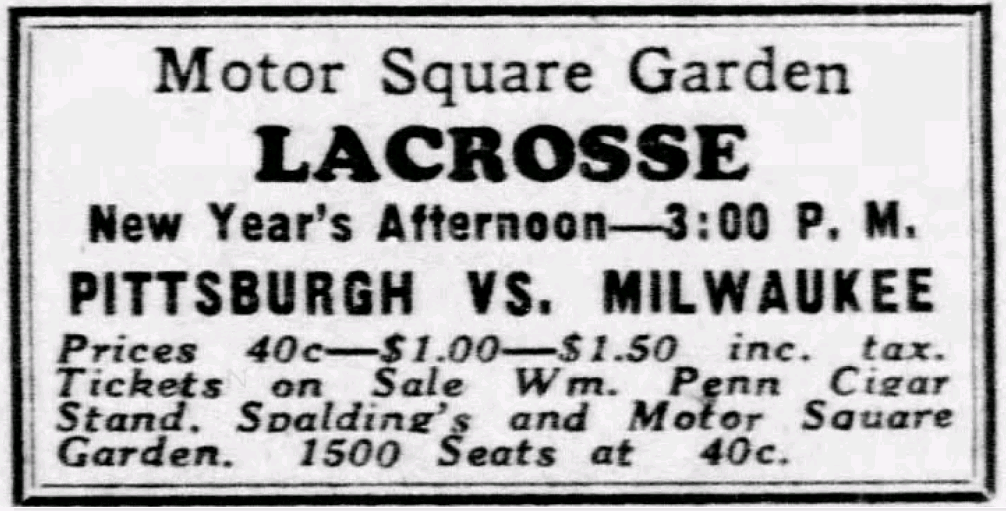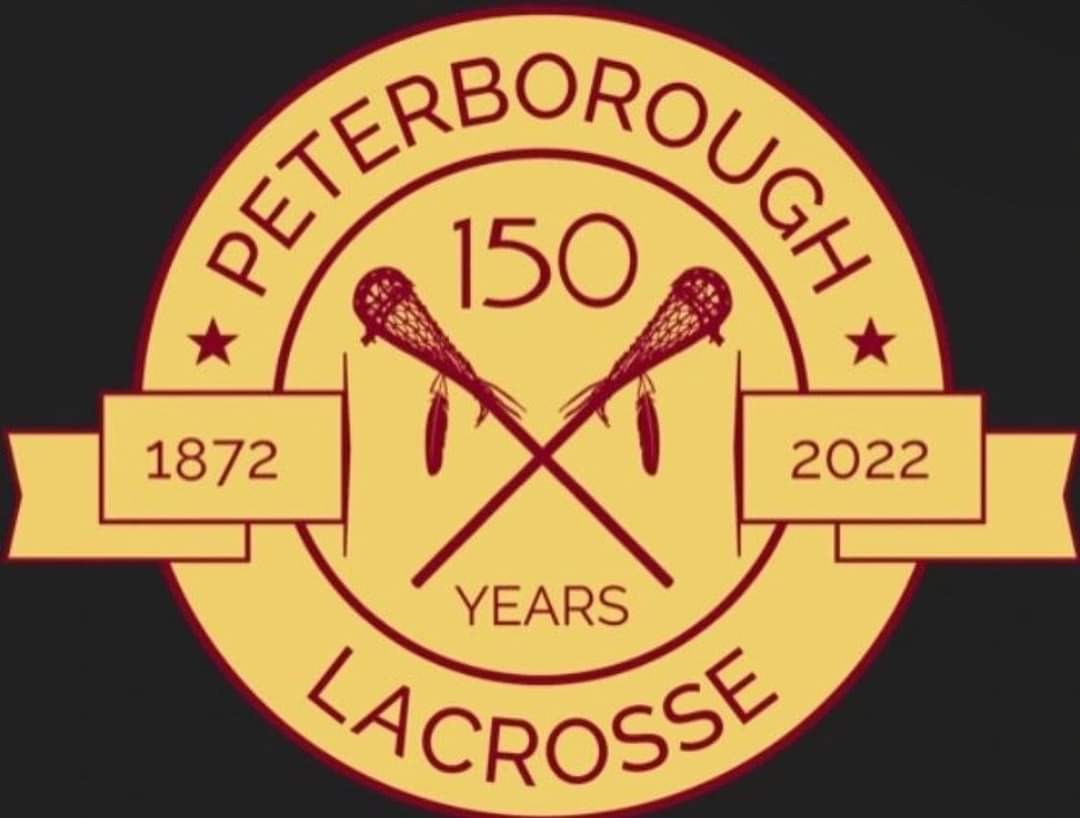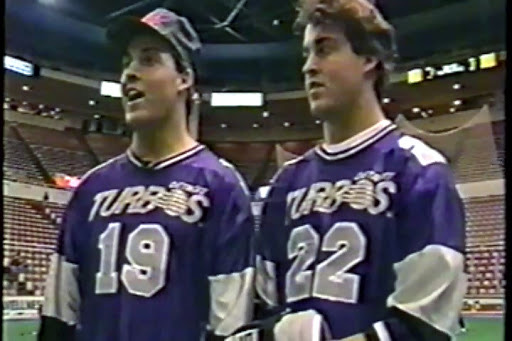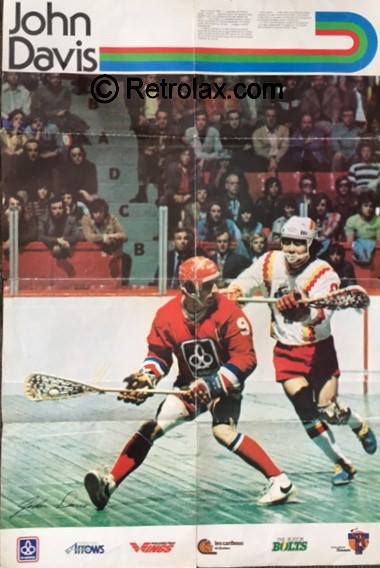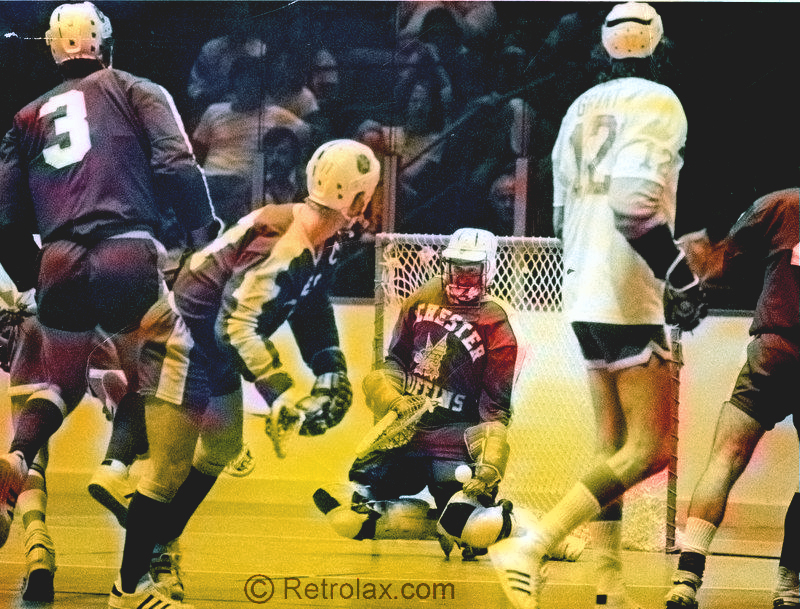by Steve Holroyd (laxmavn@aol.com)
The spring of 1990 found the Major Indoor Lacrosse League finishing its fourth season. Starting with four teams in 1987, the circuit numbered six by 1990, and crowds had continued to grow steadily. While still a decidedly low-budget operation—players still only earned about $100 a game in an 8-game schedule—the MILL still managed to do what none of the previous attempts at professional lacrosse had: survive beyond a second season.
Of the course, the MILL was an exclusively U.S.-based league at the time, and was still committed to its original plan of primarily utilizing American players who had played field lacrosse in college. This meant that Canada—birthplace of box lacrosse, the country’s national game—was still without professional lacrosse.
In the summer of 1990, a group of individuals decided to change that, as plans were made to establish a professional Canadian league. By August, the new league had received a commitment from The Sports Network to televise the league’s semi-finals and finals.[i] Teams in the Ontario centers of Brantford, Guelph, and Whitby, along with a team in Newtown, N.Y., committed to the endeavor and, on November 28, 1990, the National Lacrosse League was launched.
An 18-game schedule beginning the third weekend of January was announced, with the championship game to be held in Brantford on April 7. The NLL would operate independently of the Ontario Lacrosse Association, which was the governing body of box lacrosse in the province, but had the OLA’s backing.[ii]
“We realize that 80 percent of these types of ventures fall apart, but professional lacrosse has been tried four or five times and we feel this time it will succeed,” said NLL President Dave Thomas, a Brampton public school vice principal. “We’re finally putting a carrot in front of the youngsters who play this game across Canada.”
Unlike the MILL, the NLL chose not to employ the “single entity” model, whereby the league owned all of the teams. Rather, the new venture would employ the traditional franchise model, with each of the original teams costing $15,000. Like the American league, players would be paid $100 per game plus traveling expenses.[iii]
The NLL would also follow the MILL in other regards. First, it would be the first Canadian professional league that would play a winter schedule—previous attempts had played in the spring and summer. In addition, NLL teams would allow players to use only plastic sticks; league officials said they hoped it would reduce the level of injuries and intimidation of the traditional wooden sticks. As in the MILL, games would be played in 15-minute quarters (instead of the traditional three 20-minute periods); teams would be required to advance the ball over the center line within 10 seconds; and there would be a 30-second shot clock. Bruce Hood, former National Hockey League referee, would be in tasked with enforcing all the new rules as the NLL’s referee-in-chief.[iv]
More than 300 players submitted their names for the NLL draft, also held on November 28, 1990. The Buffalo Renegades—playing out of Newtown, NY—won first pick through a lottery system and selected Barry Powless, a 33-year old teacher at an Onondaga Nation elementary school outside Syracuse, N.Y.
Of course, Powless was more than just a school teacher—he had played senior lacrosse in Fergus, Ontario the previous summer and was a member of the Coquitlam Mann Cup finalists in 1988. He also starred in the Nations In 1980 international tournament a decade earlier.
He also bore a name that was legendary in Ontario—he was a distant relative of Ross and Gaylord Powless. “I have a picture in a scrapbook of my grandfather when he played lacrosse,” said Barry. “It’s a family tradition. I have an opportunity now to fulfill a dream of playing lacrosse at its highest level.”[v]
The Guelph Power picked second, tabbing Ken Passfield, goalie from the Mann Cup champion Brooklin Redmen. Each of the four teams chose 30 players. Among the selections of the Whitby Steel Hawks was Paul Day (current coach/general manager of the Philadelphia Wings and long-time general manager of the Peterborough Petes).
Plans for 1992 called for two additional teams in the east, and the addition of a western division based in British Columbia. As with the 1972 version of the NLL, however, the western teams were a bit more restrained in their enthusiasm for professional lacrosse. “It’s in the talking stages,” said K.C. Cook, president of the New Westminster Salmonbellies of the Western Lacrosse Association. “We’re going to have a good look at their league and see how it goes back [east].” Cook allowed that the formation of the NLL was a step in the right direction, but also made it clear that the new league would not simply come west at the expense of the WLA. “We have a very viable league and a good league out here,” said Cook. “It’s a different set of circumstances out here.”[vi]
Thomas remained optimistic: “It’s an ambitious plan, but dreams come true if you go one step at a time and this is just our first step.” By 1993, the NLL hoped to introduce an interlocking schedule between the east and west divisions and expand the schedule to 24 games. In addition, plans were afoot to establish a North American championship with the champions of the MILL.[vii]
In January 1991, the NLL debuted as planned. However, it was quickly apparent that—even with salaries at $100 per game per player—the league was woefully undercapitalized. In the rush to start the league, Whitby did not even secure an arena.
And the fans stayed away in droves. While some crowds would be in the 1,000 range, many others were in the double digits. Guelph player Jeff Garlin shares this amusing anecdote:
Whitby at Guelph: attendance 35. Early in the 1st period a line brawl starts. Everybody ends up in a scrum by the glass. Some fan about 50 years old leans over the glass and starts yelling “I paid to watch a lacrosse game not a bunch of idiots fighting.” I looked up and said “go fuck yourself.” He turns to the group he came with and says something to them; they all put on their coats and leave.
After the game, a coach or GM from Guelph angrily comes up to me and says “We got 35 fans…you tell him off and they leave!” I said, “Well, at least they paid.” He replied, “No…they were so mad I had to give them all a refund!”
Oops. Total paid attendance: 29[viii]
While Guelph may not have drawn well, they were nevertheless the class of the league. Operated by men out of the lacrosse hotbed of Peterborough, the Power finished the year 12-4 to win the regular season crown. The storied Brantford Warriors team, adopting a “war of attrition” style of play, finished 9-8 while leading the league in both goals scored and goals conceded; for his heroic weathering of the onslaught, Warriors netminder Barry Maruk was named a first-team all-star.
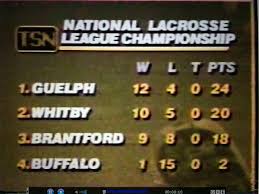
Derek Keenan of Whitby led the league in goals with 39; teammate John Fusco paced the circuit in assists with 49. Guelph paced the league defensively: Jeff Hardill was named Best Defensive Player, and goaltenders Terry Preston, Ken Passfield, and Steve McMillan combined to yield the fewest goals against. Keenan was also named NLL Most Valuable Player
With only four teams, all of the sides entered playoff weekend in Brantford, with all three games televised on TSN. On April 7, 1991, Brantford Warriors defeated Whitby, 12-9, and Guelph breezed past the woeful Buffalo Renegades—who finished 1-15 during the season—by a 19-8 score.
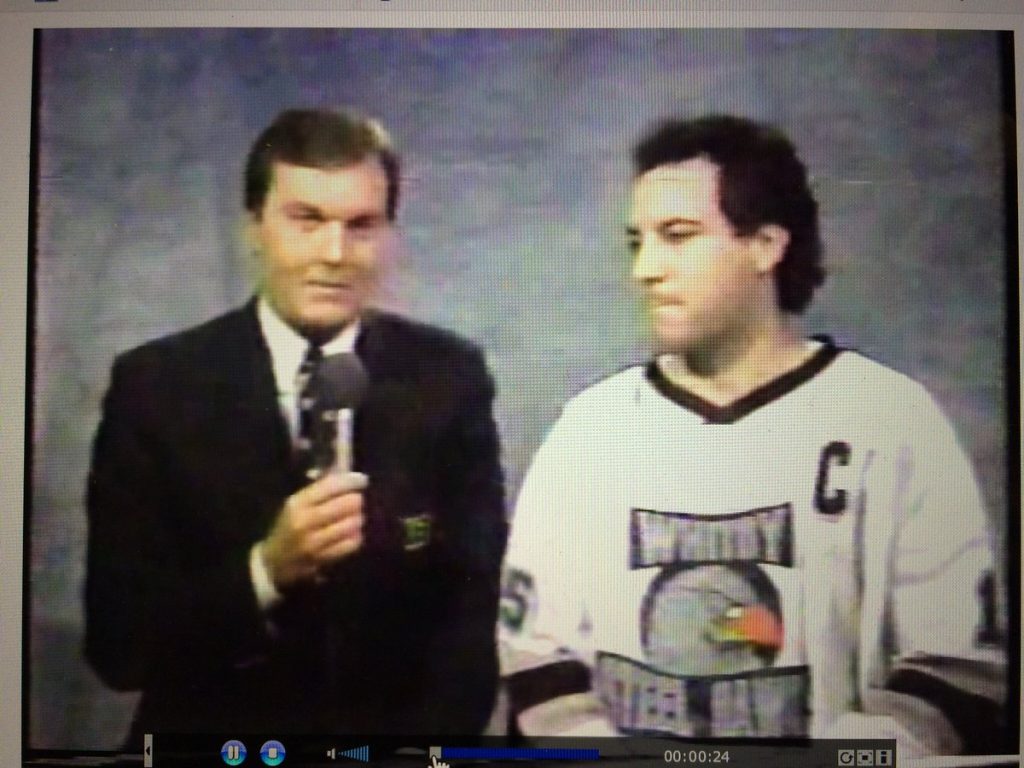
The next day, Gary Walker scored twice to lead Guelph to the title in a thrilling 11-10 victory over Brantford. The Power blew a 7-2 lead, and trailed 8-7 midway through the third quarter before rallying to win the Nations Cup. (Incidentally, the waterboy for the champions: John Grant, Jr.)
Its first season completed, the league would not see a second. Buffalo folded shortly after the season; Whitby—still lacking a suitable arena—announced it was moving to Oshawa. And champion Guelph—hoping for greater crowd support—announced it was moving to Peterborough for the 1992 campaign.
By November 1991, however, the underfunded Power had also folded. Down to only two teams, the NLL soon followed suit.
FINAL STANDINGS
| TEAM | GP | W | L | T | GF | GA | TP |
| Guelph Power | 16 | 12 | 4 | 0 | 241 | 174 | 24 |
| Whitby Steel Hawks | 15 | 10 | 5 | 0 | 207 | 189 | 20 |
| Brantford Warriors | 17 | 9 | 8 | 0 | 287 | 245 | 18 |
| Buffalo Renegades | 16 | 1 | 15 | 0 | 190 | 307 | 2 |
[i] Montreal Gazette, August 19, 1990
[ii] “New league to hold draft,” Ottawa Citizen, November 28, 1990
[iii] “Lacrosse gambles with pro league,” Edmonton Journal, November 29, 1990 (CP report)
[iv] “Lacrosse gambles…”
[v] Id.
[vi] “League unveiled,” Vancouver Province, November 29, 1990
[vii] “Lacrosse league formed,” Nanaimo Daily News, November 29, 1990 (CP report)
[viii] Tweet by @JayGar19, January 4, 2019

